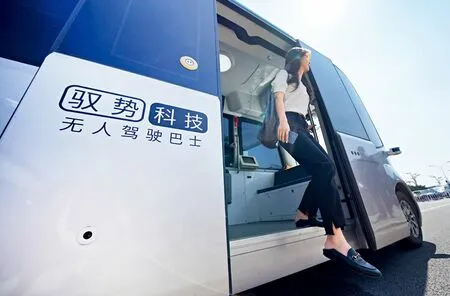Minor Players,Major Drivers
By Tao Zihui
New batch of“little giants”champions China’s upgraded SME cause

1.A worker on a production line of an electric motor plant in Tangshan,Hebei Province,September 9,2021.(DONG JUN)
If light is the way to dispel darkness,then Beijing-based Landsky Technology Group Co.,Ltd.narrates a bright and fascinating way of displaying optical technology.
“Light is no longer just for illuminating objects.A welldesigned lighting scheme can make people truly sense their surroundings,”Liang Ye,a senior manager at Landsky,said.Coming in from this perspective,the hi-tech enterprise in the field of lighting technology has focused its research and development (R&D) efforts on enriching the relationship between light and life,light and space,as well as that between light and nature.
An official provider of the creative light and shadow show services for the Olympic and Paralympic Winter Games Beijing 2022,Landsky undertook more than 10 lighting projects,including those of the National Speed Skating Oval,dubbed the Ice Ribbon,and the Olympic Tower in the capital city’s downtown areas.
The team developed an adjustable“bracket”so that the light illuminating all 3,520 sections of the Ice Ribbon could pass through it at the Fibonacci angle,also known as the golden angle for light capture.The innovative achievement won the company the 2021 national utility model patent accolade.
“The keyword is ‘innovation.’ We are committed to presenting top-notch industrial innovation applications,”Liang said.
The pursuit of innovative excellence has also put Landsky among a new generation of startups selected under China’s greater emphasis on cultivating competitive small and medium-sized enterprises (SMEs),known as little giants.These companies,according to official definition,focus on a niche market and master key technologies with strong innovation capacity.More importantly,the smaller players are likely to become future champions in bottleneck sectors.
Tech Applications
Landsky semiconductor lighting display products are used in broadcasting,sports venues,control rooms and exhibitions alike.“Technology,both in production and in life,should benefit people.Its real-time application is crucial,”Liang said.
The company today has implemented its nightscape improvement projects across several cities.Urban in-and outdoor lighting has been developed to create a citywide smart lighting environment,for example lending Beijing a new edge for the development of its nighttime tourism,according to Liang.He believes the future holds a bigger role for the business in the larger corporate-scape—outside the lighting segment.
His confidence is further substantiated by the government’s supporting policies.The 2022 government work report,released in March during the fifth session of the 13th National People’s Congress,said China would up its efforts to nurture small,specialized and sophisticated enterprises.
According to a report released by the Ministry of Industry and Information Technology (MIIT)in 2020,SMEs generate some 70 percent of technological innovations nationwide.Though only accounting for a small proportion of SMEs in China,the average growth rates of the little giants’ revenues,profit margins and invention patents held far outpace those of the entire group,Xiao Yaqing,Minister of Industry and Information Technology,explained.
Generally,a little giant’s main business income or net profit should register an average year-on-year growth of no less than 5 percent in the previous two years,and its debtto-asset ratio should remain below 70 percent.Other requirements include R&D expenditure as a proportion of revenues.
Currently,China has over 4,700 little giant firms,half of which have an annual R&D spending topping 10 million yuan (US$1.57 million),according to MIIT data.Also,over 60 percent are engaged in fundamental industrial techniques,and over 70 percent have been deeply involved in an industrial niche for more than 10 years.

2.A self-driving minibus developed by UISEE provides transit service for Chinese and foreign visitors to the autonomous driving area at the China International Fair for Trade in Services on September 5,2020.(VISUAL.PEOPLE.CN)

3.A worker on the production line of YT Process Engineering Ltd.,a national high-tech enterprise in Shenyang,Liaoning Province,February 22,2022.(VCG)
70%
According to a report released by the Ministry of Industry and Information Technology (MIIT) in 2020,SMEs generate some70 percentof technological innovations nationwide.
The government guideline on the development of SMEs during the 14th Five-Year Plan (2021-25) period,jointly released by the MIIT and 19 other departments,states that by 2025,the country will incubate 10,000 little giants.
“This year,we aim to cultivate 3,000 new national-level little giants,and we hope they will eventually become role models for other SMEs,”Xiao said on March 8.Over 90 percent of enterprises in China are SMEs,and the favorable policies applied to little giants would be gradually expanded to other companies to better buoy industrial growth,he added.
A Commercial Push
Some argue that China’s push for the niche companies is a“quick-take”in its vast blueprint for scientific and technological catch-up.Yet it was more than one decade ago,in 2011,that the MIIT already vocalized,for the first time,how specialization and innovation should be seen as important ways for SMEs to transform and upgrade.
Lu Benfu,vice chairman of the China Institute for Innovation and Development Strategy,said the little giants,able to fill in certain domestic weak spots,will help improve the industry and supply chains.
“For China,innovation capabilities and well-rounded supply chains have taken on an increasingly prominent role in the economy,particularly in the development of its digital sectors,”Lu said.
“Certainly,we need to work harder to enhance technological innovation and emergency responses,as well as speed up breakthroughs in key technologies such as high-end chips and fundamental software,to deepen the integration of the digital and real economies,”he added.
Last year,Wu Gansha,chairman and CEO of self-driving startup UISEE,received the national-level“little giants”recognition for his company after a government review of its technology.Its newfound byline gave the company an extra dose of credibility—and financial support.Over the course of 2021,the company managed to raise more than 1 billion yuan (US$157 million),government funds included.
In recent years,China’s self-driving car industry has seen explosive growth,rising from a small sector to an area receiving significant backing from the government and venture capital funds alike,and giving rise to a class of startups seeking to commercialize their technologies,hoping to become the first to get a viable product on the road.
UISEE,which has been deploying full-scene autonomous driving from the very beginning,has accelerated its commercialization efforts in 2021,implementing its technology across multiple scenarios,including airports,industrial settings and unmanned buses.
By December 2021,the startup’s vehicles had accumulated over 1.2 million kilometers of commercial service,company data showed,making it the world’s first of its kind to cross this threshold.
From road sweepers and delivery vehicles to logistics vehicles operating at ports or airports,“in the field of autonomous driving,traditional automakers,too,are actively embracing new technologies and cooperating with tech companies,”Wu told news portal ThePaper.cn.“This seems to have become a big trend in the field of autonomous driving.”

